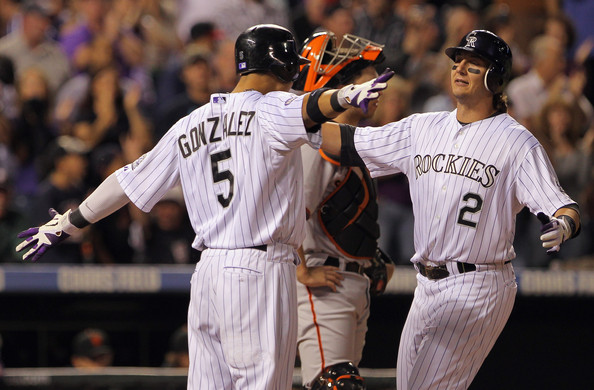 All the buzz surrounding the Mets this week as the trade deadline fast approaches has been about Rockies shortstop Troy Tulowitzki. I wrote extensively yesterday about why he is a good trade target for the Mets. However, reports indicate it is far more likely the Mets acquire Tulowitzki’s teammate, outfielder Carlos Gonzalez.
All the buzz surrounding the Mets this week as the trade deadline fast approaches has been about Rockies shortstop Troy Tulowitzki. I wrote extensively yesterday about why he is a good trade target for the Mets. However, reports indicate it is far more likely the Mets acquire Tulowitzki’s teammate, outfielder Carlos Gonzalez.
No one is going to argue that Gonzalez is anywhere near the level of Tulowitzki, but there are varying opinions on him. On the surface, his numbers are outstanding for his career. In 2013, he hit .302/.367/.591 with 26 home runs, 21 stolen bases, and six triples in only 110 games. From 2010 through 2013, Gonzalez hit .311/.370/.556 with a 133 OPS+.
Those are outstanding numbers and make Gonzalez appear to be the perfect outfield bat for the Mets to acquire. While he will not cost quite the package that Tulowitzki would in a trade, his cost will presumably be very high. And unlike with Tulo, he is a player the Mets have to pass on.
Many reporters and fans have made a big deal about Tulowitzki’s road numbers. Yet, considering his position, his road numbers are still outstanding. For Gonzalez, they are quite concerning.
Away from home, Gonzalez has hit .260/.315/.441 in his career, compared to .333/.365/.546 at Coors Field. On the road, that’s a 102 wRC+, or just two percent better than league average. For left fielders, that is just a tick above average. Unlike Tulowitzki, who had a 118 wRC+ on the road, Gonzalez’s bat doesn’t translate away from Coors Field. Both clearly suffer on the road, but even so, Tulo is still 50 percent better than the average at his position, while Gonzalez hovers at just around his own positional average.
On the road, Gonzalez strikes out much more frequently, hits more ground balls and fewer line drives, and sees far fewer of his fly balls leave the park. In Coors Field, Gonzalez sees an astounding 21 percent of his fly balls leave the park (compared to a 9.7 percent league average). On the road, that drops to 15.6 percent.
Although he had a fantastic season last year in which his splits were reversed, the sample size on those numbers isn’t big enough to say anything definitively. Plenty of players hit against the platoon split or against their ballpark’s tendencies for an entire season, but that doesn’t mean they have necessarily overcome that obstacle. For Gonzalez, it is surely a fluke.
To make things worse, Gonzalez is having his most disappointing season to date, batting .244/.293/.437 (well below league average) with ten home runs in 63 games. On the road, he is hitting .169/.234/.346. (That’s still better than Lucas Duda against left-handed pitching, if that’s at all comforting.)
On the financial side, Gonzalez’s contract is much shorter than Tulo’s with only three years and $54 million left, but that is still a big commitment for the big question mark Gonzales is. The average annual salary ($18 million) on that deal is close to what Tulowitzki will be paid.
If the Mets are going to give up Noah Syndergaard or Zack Wheeler, which they probably would in a Gonzalez trade, they need to get a well above average bat. The two clear positions to upgrade, at least if Daniel Murphy remains, are left field and shortstop. If you plug in an average hitter in left field, you almost have to acquire a star shortstop with the way this year’s offense has struggled. Who is out there to fit that bill? The only two obvious candidates are Ben Zobrist and Troy Tulowitzki, and not much else. You still have to give up a big package. In fact, you then have to do it twice. If the Mets are going to give up big pitching prospects, it has to be for someone who will give you consistently above average production.
Gonzalez is just not that player.
(Note: Statistics are as of 10:00 p.m., July 29) Follow me on Twitter @UpAlongFirst















